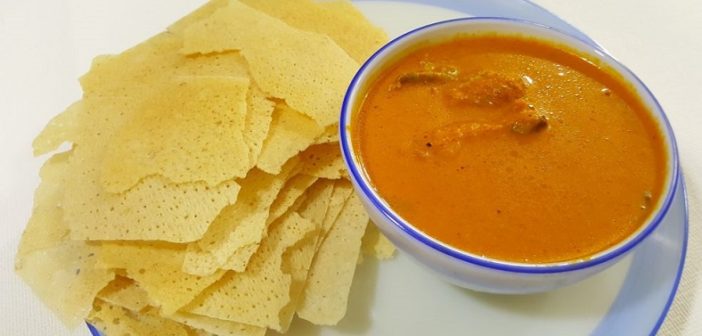Among the many unsung culinary treasures of India lies a simple yet deeply satisfying dish called Korri Roti — a heritage meal from the Tulu-speaking region of coastal Karnataka, particularly Mangalore and Udupi. Translating literally to “chicken and roti”, Korri Roti is far more than just a combination of poultry and bread. It is a deeply cultural, historically rooted dish that tells stories of agrarian pride, coastal abundance, community gatherings, and culinary ingenuity. With its crackling dry wafers of rice and a fiery, fragrant chicken curry, Korri Roti stands as a testament to how simplicity can rise to sublimity.
Origins in the Heart of Tulunadu
Korri Roti is native to the Tulu Nadu region — encompassing Mangalore, Udupi, parts of Kasargod, and adjacent Karnataka coastal belts. This dish is closely tied to the Bunt community, a landowning warrior-agricultural caste known for their hospitality, distinctive cuisine, and social customs. In traditional Bunt households, Korri Roti is more than just food — it is a mark of status, tradition, and festivity.
The invention of this dish is believed to have stemmed from resourceful cooking practices. Coastal Karnataka has an abundance of rice, and communities began to use rice not only as steamed grains but also in fermented, roasted, and dried forms. The rotis (which are more like crispy rice sheets or crackers) were a way to preserve rice batter longer and serve it in non-conventional textures — a practice born from monsoon limitations and rice surpluses.
A Dish of Occasion and Honour
In Tulu households, especially among Bunts, Korri Roti is often made during celebrations — weddings, cradle ceremonies, festivals, and other community feasts. It is also a default menu item when honouring important guests. The labor involved in making the rotis from scratch — soaking, grinding, fermenting, drying, and roasting — is immense and often a group activity, handled by experienced women of the house or hired cooks during big functions.
Serving Korri Roti is a symbol of respect and welcome. It shows that the host has made an effort, and offers a plate that is local, seasonal, and celebratory. In rural homes, these rotis are still made in backyard fire pits using terracotta griddles and served in traditional bell metal utensils.
What Is Korri Roti Made Of?
The Roti:
Contrary to the wheat rotis of north India, the ‘roti’ in Korri Roti is made from rice batter. The process involves:
-
Soaking raw rice for several hours.
-
Grinding it into a smooth, slightly fermented batter.
-
Spreading the batter on hot iron tavas or steel griddles as thin as paper.
-
Letting it dry and roast into a crackly white sheet with gentle golden edges.
These sheets are dry, crisp, and shatter in the mouth like chips. They are shelf-stable and can be stored for weeks in airtight containers.
The Chicken Curry (Korri Gassi):
The other half of the dish is the Korri Gassi — a Mangalorean-style chicken curry that’s fiery, aromatic, and coconut-rich. Its preparation includes:
-
Fresh chicken pieces (bone-in preferred).
-
Roasted dry spices: coriander, cumin, fenugreek, cinnamon, cloves, and pepper.
-
Byadgi red chillies for both heat and deep red colour.
-
Fresh coconut ground with garlic, onions, and ginger.
-
Tempering with curry leaves, mustard seeds, and optionally ghee.
The curry is simmered until thick, luscious, and infused with spice. Its medium-thick consistency is perfect for softening the crunchy roti, without turning it soggy too soon.
How It’s Eaten
The roti is broken by hand into bite-sized chunks and placed on a plate. Hot chicken curry is ladled over it, slowly soaking it. The contrast of textures — the dry crispiness of the rice wafers and the warm, spiced curry — creates an experience that’s earthy and indulgent.
Some people prefer their roti ultra-crunchy with just a touch of curry. Others let it soak for a few minutes until it becomes soft and chewy like a rice cake. The dish adapts beautifully to personal preferences.
Cultural Symbolism and Identity
Korri Roti is a symbol of Tuluva identity and pride. It is to Mangaloreans what sarson da saag is to Punjabis or dhokla to Gujaratis — a cultural cornerstone. For NRIs from the coastal Karnataka region, Korri Roti is a taste of home and nostalgia. Families in the US, UAE, and Australia often import packets of the roti or make their own using flat ovens and new-age air fryers.
The dish is also a marker of community-specific culinary traditions. While the Bunt community is most known for preserving the dish, other coastal communities such as Billavas and Mogaveeras also serve it with regional twists.
Modern Variants and Evolutions
Like all great traditional dishes, Korri Roti has inspired several variants and contemporary interpretations:
-
Vegetarian Versions: Some substitute the chicken with mushroom gassi, tofu curry, or even kadle gassi (black chickpeas curry).
-
Seafood Rotis: In coastal areas, prawn curry or crab masala is used instead of chicken.
-
Fusion Dishes: Some fine-dining restaurants in Bangalore and Mangalore serve Korri Roti in deconstructed formats — rotis served as chips with curry as a dip or layered like a lasagna.
-
Packaged Rotis: With growing demand, many Mangalorean shops and online platforms now sell ready-to-eat rotis in vacuum-sealed packs. These can be stored for months and just need curry to complete the meal.
Nutritional Profile
Korri Roti is surprisingly light and gluten-free, thanks to its rice base. It’s low in fat (unless ghee is used) and contains no additives. The chicken curry is protein-rich and packed with antioxidants from spices and coconut. However, it can be heavy if eaten in large quantities, especially when prepared for festivals with rich oils.
A healthier version would use lean chicken, coconut milk instead of paste, and less oil in the tempering. The rotis can be air-dried rather than roasted in ghee.
Where to Find and How to Try
If you’re in Karnataka, the best place to try authentic Korri Roti is Mangalore or Udupi. Famous eateries such as Woodlands Hotel, Giri Manja’s, or Hotel Janatha Deluxe are known for their authentic versions. In Bangalore, places like Coastal Mama, Mangalore Pearl, and Machali offer stellar renditions.
For those outside Karnataka, online retailers and Tulu caterers in metro cities now offer home delivery of rotis and even vacuum-sealed chicken curry. The rotis can also be made at home if you have a non-stick tawa, rice, and patience.
Conclusion: Crunch, Culture, and Comfort
Korri Roti is more than a dish — it’s a culinary echo of tradition, storytelling, and community. It captures everything that is beautiful about Indian regional food: resourcefulness, celebration of local ingredients, complex flavour from simple elements, and a strong emotional connect.
In an age where Indian food is increasingly being reduced to butter chicken and naan on global menus, Korri Roti reminds us of the deep regional diversity and culinary brilliance that lies waiting in every coastal town, every ancestral kitchen, and every heirloom recipe.
Next time you crave something different, ditch the predictable. Try a plate of Korri Roti — and crunch your way into one of India’s most soulful food traditions.






